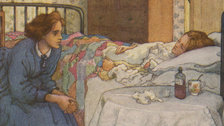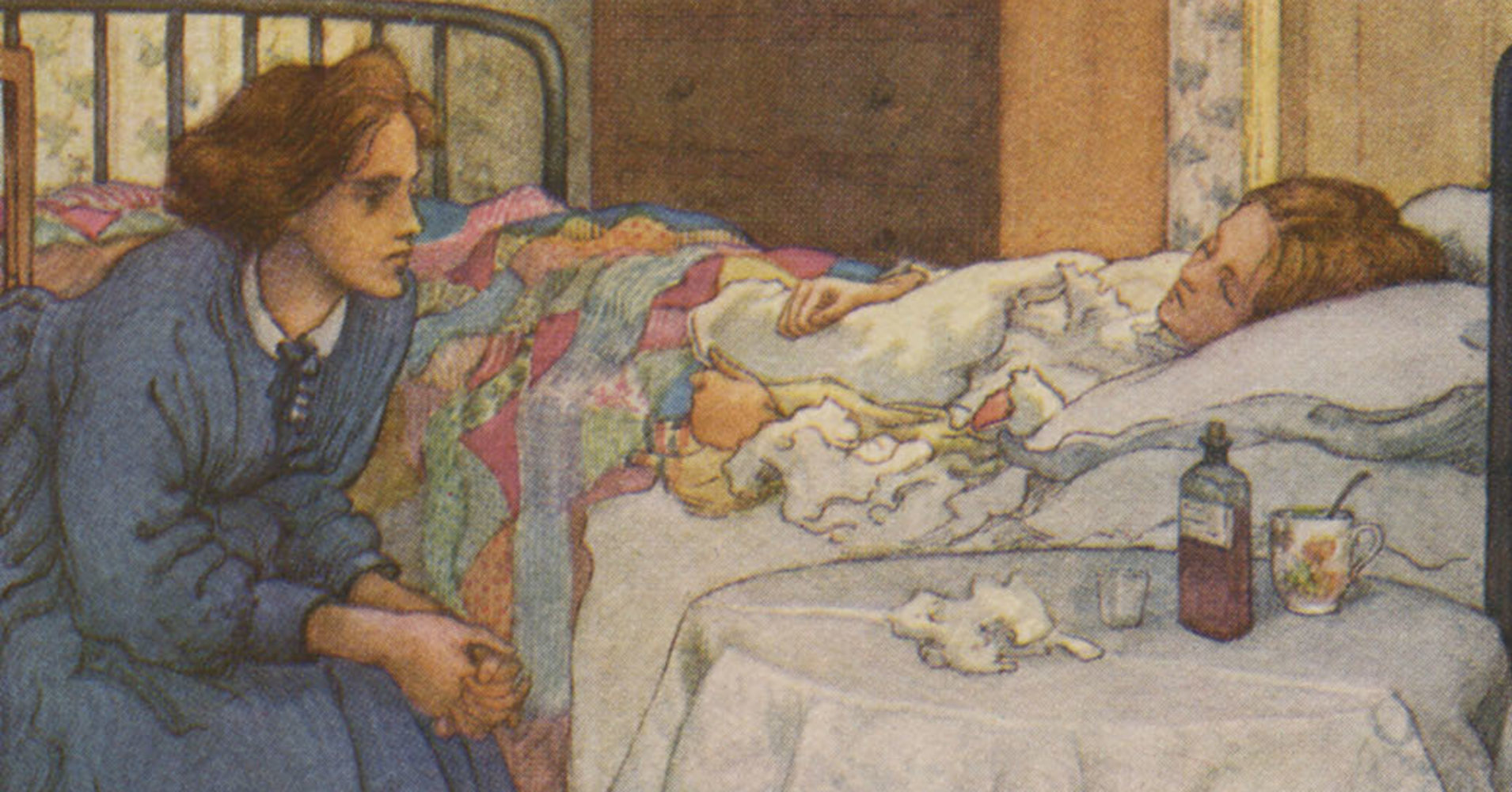[ad_1]

People, we all know from fiction, come in four varieties: The one you want to be, the one you say you actually are, the one you self-deprecatingly say you might be, and the one no one wants to touch. Gryffindors, Ravenclaws, Slytherins, Hufflepuffs. Samantha, Miranda, Carrie, Charlotte. And of course, Jo, Meg, Amy, Beth.
Well before the day that I learned to concede, with immense humility, that I might be a Ravenclaw instead of a Gryffindor like my idol Hermione Granger, the March girls of Little Women were my archetypes of choice, as they were for many girls I knew. Nearly everyone wanted to be writerly Jo, whom author Louisa May Alcott based on herself. She was the ideal. Who wouldn’t want to be bold like Jo, opinionated like Jo, ambitious like Jo? A few preferred artistic, golden-haired Amy. Some would admit they were, in truth, a bit more drab and sensible ― a domestic Meg, perhaps.
No one wanted to be a Beth. It’s not just that she dies tragically young; it’s that while she’s alive, she’s treated like the wallpaper. By choice. The depiction is so two-dimensional, it’s surprising to find out that it’s directly drawn from Alcott’s beloved sister Elizabeth, who also died young after being weakened by scarlet fever contracted while aiding a poor immigrant family.
In Alcott’s book and the many adaptations of it (a new miniseries or film is seemingly always on its way, with a new project helmed by Greta Gerwig recently announced), Beth March is dull, timid and devoid of ambition, a homebody so homebodyish that she can’t even conceive of leaving her current home to make her own home and family one day. A ’90s girl like me and my friends couldn’t relate to that. We raised our hands in class and read American Girl magazine articles about 13-year-old entrepreneurs named Kelly who sold handmade Beanie Baby sleeping bags. We were leaning in. Who would want to be a Beth?
I did. I desperately wanted to be a Beth.
Maybe it was because I already resembled Jo in all the worst ways. The adorable boy next door never fell helplessly in love with me, and I didn’t have an imaginative mind teeming with stories. What I had was a vindictive streak, a distaste for doing chores and complete lack of restraint when it came to sharing my thoughts and opinions. And, like Jo, a lot of impotent shame about it.
Jo was the captivating misfit of her day, at odds with the dominant feminine ideal. Beth and, to lesser extents, Amy and Meg embodied that Victorian feminine ideal: demure, neat, nurturing, subservient, decorative. Alcott describes Beth as “everyone’s friend, and an angel in the house.” The angel in the house was a common fiction archetype of the time ― a saintly female figure who turns a family’s home into a warm, comforting space.
Jo, who adores Beth, often laments her own failings in this arena and tries to emulate Beth. As Beth lies dying, she tells her older sister, “You must take my place, Jo, and be everything to Father and Mother when I’m gone. They will turn to you, don’t fail them … You’ll be happier in doing that than writing splendid books or seeing all the world, for love is the only thing that we can carry with us when we go.” Jo agrees to try, and in her grief learns to temper her more rebellious impulses and to play a soothing, homemaking role for her family.
Her arc resembles other 19th and early 20th century novels of girlhood, including some that are popular to this day. As a kid, I also read and reread Susan Coolidge’s What Katy Did, a cheery novel about a hoydenish adolescent girl who is confined to bed after bruising her spine in a freak accident. Inspired by her saintly invalid cousin Helen, Katy learns to be useful and beloved even from her sickbed by becoming neat, patient and optimistic and an emotional resource to her family. At the end, once her spirit has been broken sufficiently for her to behave acceptably as a woman, her injury begins to heal. In the Eleanor H. Porter novel Pollyanna, the heroine starts out a saintly, determinedly cheerful figure but must relearn the value of a sunny, giving spirit after an accident leaves her unable to walk. It was a bleak century for the moody, messy chicks.
Beth never puts a foot out of line or asks for anything for herself, and the result is that she’s literally too good to live.
By the time I read Little Women, feminists had rehabilitated Jo’s brand of womanhood. Her recklessness toward her hair and clothes betokened a fetching lack of primness, and her impetuousness signaled female empowerment and independence. Plus, the cute boy fell in love with her, despite her tomboyish ways! She was a ready-made millennial queen, everybody’s favorite. It was no longer trendy to aspire to be the angel in the house, especially an angel in the house who dies before she has the chance to marry a clean-cut Mormon and start a mommy blog.
Still, I wanted to be a Beth. I wanted to be nice ― really, deeply, effortlessly nice. I wanted all my first impulses to be saintly instead of selfish. I wanted to be so pure that everyone would want to protect me and so fragile that they’d need to. I wanted to be a martyr to the very concept of being blameless. I wanted to be the most generous-hearted, unassuming, wide-eyed girl you know.
I wanted to never be in the wrong.
Not being wrong is one of my favorite things in the world, and yet I spend half my life being a dick and the other half desperately trying to stop myself from being a dick. Beth never has that problem, even once. Somehow she even plays the piano in a virtuous way. Meg, Jo and Amy all have their moments of petulance, cruelty or superficiality; all Beth does is love her sisters and help poor people.
This isn’t an exaggeration. In the book, the worst thing Beth ever does is agree to take a week off of doing chores along with her sisters. And she doesn’t even do that! She is the only sister who still does some of her chores. When, at the end of the week, Marmee teaches them all a lesson about shirking their duties, poor Beth humbly accepts it, even though she barely did anything wrong. She’s got the backbone of one of her beloved rag dolls, and I wish I were like her.
Aspiring to be like Beth is akin to aspiring to be like Jesus: It’s admirable in theory, but you’re always going to come up short in a major way, because your idol, though based on a real person, is more a fictional construct representing perfect goodness than a human being.
But Beth, in a way Jesus Christ does not, represents a specifically feminine ideal. She’s the distilled essence of so many standards of white womanhood — giving, demure, maternal yet virginal, tenderhearted and kind, devoted to her family and home. She’s the voiceless conscience of the house, always setting the right example but not presuming to lecture. Then she graciously dies before she can either do anything so greedy as binding a man in matrimony or as superfluous as growing into a withered spinster aunt.
Beth is the logical conclusion of the conflicting, confining expectations long placed on women. Not getting one’s hands dirty is an indulgence that has long been granted to certain classes of white women in America, not to mention a convenient stricture on their political and social autonomy. Beth never puts a foot out of line or asks for anything for herself, and the result is that she’s literally too good to live.
Much of ‘Little Women’ and its sequels represent Alcott’s own reluctant bending to societal expectations of womanhood.
Despite growing up in a more progressive, Jo-loving era, I was profoundly susceptible to the allure of the ethereal pedestal Beth lived on, a “cherished … household saint in its shrine.” Despite “go, girl” slogans and “you can have it all” ideology, the cultural discomfort with flawed, loud, ambitious women had not and has not disappeared.
It can be exhausting to push against that discomfort. It’s almost easier to give in to the self-loathing, to hate that your personality is too sharp and your desires too grandiose. It’s easier to try to be the Beth, to make a bid for the approval of the benevolent sexists who hold doors open for “ladies” and vote against abortion rights. Maybe Beth accomplishes little in her life, but at least no one can find fault with her. It’s an appealing thought.
While Little Women seems bent on molding Jo, Amy and Meg into the perfectly conventional wives and mothers, it’s hard to buy that Alcott would want young women to aspire to the same. She wrote a children’s novel only at the behest of her publisher and famously called it “moral pap for the young.” A radically political woman who worked as a Civil War nurse and wrote scandalous potboilers, she chafed at the didacticism and conventionality of the genre. Much of Little Women and its sequels represent Alcott’s own reluctant bending to societal expectations of womanhood ― that she offer virtuous lessons instead of adventurous tales. The books track not just the girls’ moral education but also their warping to the pressure to fit the feminine ideal.
Beth, already so perfectly fit to it, has nowhere to go but heaven.
Perhaps this was Alcott’s quiet rebellion against the moral pap she was dispensing, to show conventional womanhood as a cul-de-sac rather than a path. Beth is denied the reward of recovery enjoyed by Katy in What Katy Did or by Pollyanna. Instead she quietly lets go of life, telling her sister as she weakens, “Jo, dear, don’t hope any more. It won’t do any good.” (Alcott’s sister Elizabeth refused treatment during her decline.)
Beth’s perfect selflessness doesn’t heal her. It makes her too small to take up space on the planet. There’s love and some admiration in Alcott’s rendering but also an honest admission: that being the perfect woman imagined by our culture means erasing oneself. What Alcott begins to grapple with, in Jo and her surviving sisters, is whether there’s any other way for a woman to be good.
[ad_2]
Source link

